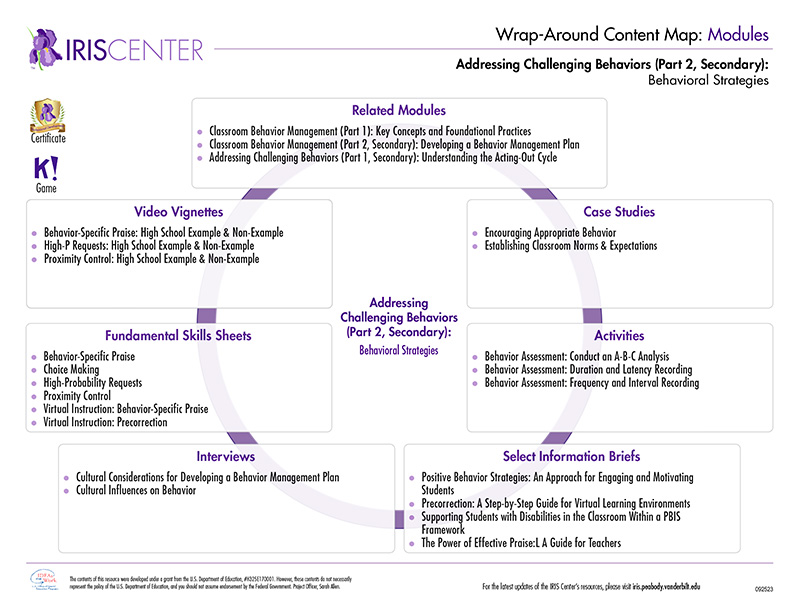Wraparound Content Maps
 Supplementary IRIS resources can be used to extend and deepen the information included in our modules and case studies, for example activities and video vignettes. By using the Wraparound Content Maps found on this page, instructors can more easily accomplish the task of broadening their own instruction and their students’ learning experience.
Supplementary IRIS resources can be used to extend and deepen the information included in our modules and case studies, for example activities and video vignettes. By using the Wraparound Content Maps found on this page, instructors can more easily accomplish the task of broadening their own instruction and their students’ learning experience.
Wraparound Content Maps for IRIS Case Studies
- Algebra (Part 1): Applying Learning Strategies to Beginning Algebra
- Algebra (Part 2): Applying Learning Strategies to Intermediate Algebra
- Beginning Teacher Support
- Comprehension and Vocabulary: Grades 3-5
- Defining Behavior
- Early Childhood Behavior Management
- Early Reading
- Effective Room Arrangement: Elementary
- Effective Room Arrangement: Middle & High School
- Encouraging Appropriate Behavior
- Establishing Classroom Norms and Expectations
- Fluency and Word Identification: Grades 3-5
- Fostering Student Accountability for Classroom Work
- Measuring Behavior
- RTI: Data-Based Decision Making
- RTI: Progress Monitoring
- Written Expression: Grades 2-5
Wraparound Content Maps for IRIS STAR Legacy Modules
- Accessing the General Education Curriculum: Inclusion Considerations for Students with Disabilities
- Accommodations: Instructional and Testing Supports for Students with Disabilities
- Accommodations to the Physical Environment: Setting Up a Classroom for Students with Visual Disabilities
- Addressing Challenging Behaviors (Part 1, Elementary): Understanding the Acting-Out Cycle
- Addressing Challenging Behaviors (Part 1, Secondary): Understanding the Acting-Out Cycle
- Addressing Challenging Behaviors (Part 2, Elementary): Behavioral Strategies
- Addressing Challenging Behaviors (Part 2, Secondary): Behavioral Strategies
- Assistive Technology: An Overview
- Autism Spectrum Disorder (Part 1): An Overview for Educators
- Autism Spectrum Disorder (Part 2): Evidence-Based Practices
- Behavioral Principles: The Basics of Understanding Student Behavior
- Bookshare: Providing Accessible Materials for Students with Print Disabilities
- Classroom Behavior Management (Part 1): Key Concepts and Foundational Practices
- Classroom Behavior Management (Part 2, Elementary): Developing a Behavior Management Plan
- Classroom Behavior Management (Part 2, Secondary): Developing a Behavior Management Plan
- Classroom Diversity: An Introduction to Student Differences
- Content Standards: Connecting Standards-Based Curriculum to Instructional Planning
- Creating an Inclusive School Environment: A Model for School Leaders
- CSR: A Reading Comprehension Strategy
- Cultural and Linguistic Differences: What Teachers Should Know
- Differentiated Instruction: Maximizing the Learning of All Students
- Dual Language Learners with Disabilities: Supporting Young Children in the Classroom
- Early Childhood Behavior Management: Developing and Teaching Rules
- Early Childhood Environments: Designing Effective Classrooms
- Evidence-Based Practices (Part 1): Identifying and Selecting a Practice or Program
- Evidence-Based Practices (Part 2): Implementing a Practice or Program with Fidelity
- Evidence-Based Practices (Part 3): Evaluating Learner Outcomes and Fidelity
- Executive Functions (Part 1): Understanding Why Some Students Struggle
- Executive Functions (Part 2): Strategies to Improve Students’ Academic Performance
- Family Engagement: Collaborating with Families of Students with Disabilities
- Fidelity of Implementation: Selecting and Implementing Evidence-Based Practices and Programs
- Functional Behavioral Assessment: Identifying the Reasons for Problem Behavior and Developing a Behavior Plan
- Guiding the School Counselor: An Overview of Roles and Responsibilities
- High-Quality Mathematics Instruction: What Teachers Should Know
- IEPs: Developing High-Quality Individualized Education Programs
- IEPs: How Administrators Can Support the Development and Implementation of High-Quality IEPs
- Improving Writing Performance: A Strategy for Writing Persuasive Essays
- Instructional Accommodations: Making the Learning Environment Accessible to Students with Disabilities
- Intensive Intervention (Part 1): Using Data-Based Individualization To Intensify Instruction
- Intensive Intervention (Part 2): Collecting and Analyzing Data for Data-Based Individualization
- MTSS/RTI: Mathematics
- PALS: A Reading Strategy for Grades K-1
- PALS: A Reading Strategy for Grades 2-6
- PALS: A Reading Strategy for High School
- The Pre-Referral Process: Procedures for Supporting Students with Academic and Behavioral Concerns
- Progress Monitoring: Mathematics
- Progress Monitoring: Reading
- Providing Instructional Supports: Facilitating Mastery of New Skills
- Related Services: Common Supports for Students with Disabilities
- RTI: Considerations for School Leaders
- RTI (Part 1): An Overview
- RTI (Part 2): Assessment
- RTI (Part 3): Reading Instruction
- RTI (Part 4): Putting It All Together
- RTI (Part 5): A Closer Look at Tier 3
- School Counselors: Facilitating Transitions for Students with Disabilities from High School to Post-School Settings
- School Nurses: Roles and Responsibilities in the School Setting
- Secondary Reading Instruction (Part 1): Teaching Vocabulary and Comprehension in the Content Areas
- Secondary Reading Instruction (Part 2): Deepening Middle School Content-Area Learning with Vocabulary and Comprehension Strategies
- Secondary Transition: Helping Students with Disabilities Plan for Post-High School Settings
- Secondary Transition: Interagency Collaboration
- Secondary Transition: Student-Centered Transition Planning
- Serving Students with Visual Impairments: The Importance of Collaboration
- SOS: Helping Students Become Independent Learners
- SRSD: Using Learning Strategies to Enhance Student Learning
- Study Skills (Part 1): Foundations for Effectively Teaching Study Skills
- Study Skills (Part 2): Strategies that Improve Students’ Academic Performance
- Teaching English Language Learners: Effective Instructional Practices
- Teacher Induction: Providing Comprehensive Training for New Special Educators
- Teacher Retention: Reducing the Attrition of Special Educators
- Universal Design for Learning: Designing Learning Experiences That Engage and Challenge All Students
- What Do You See? Perceptions of Disability
- Working With Your School Nurse: What General Education Teachers Should Do To Promote Educational Success for Students with Health Needs
- Youth with Disabilities in Juvenile Corrections (Part 1): Improving Instruction